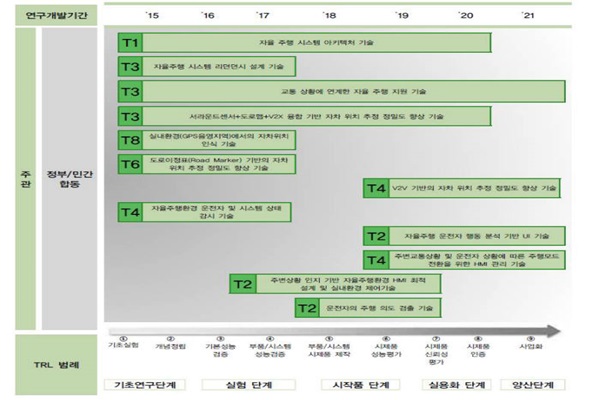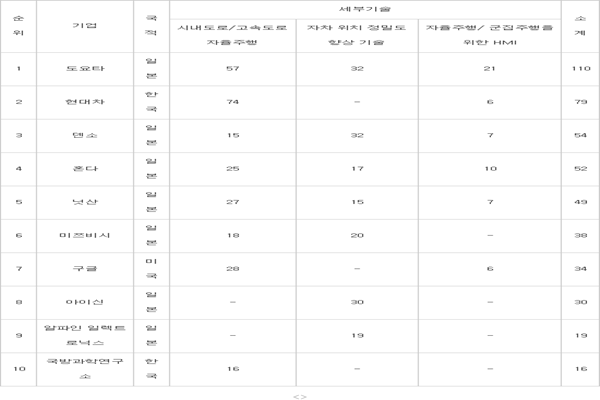Technologies for self-driving cars have reached a point where they are now ready to be commercialized. Due to the needs of evaluation and confirmation of prototype’s performance, deviation verification technology in indoor environment and technology that improves degree of precision of location estimation based on road marker were chosen as important technologies because the competition in the market is imminent.
Korea Intellectual Property Strategy Institute (KIPSI) is working on ‘Business that establishes blueprints for national patent tactics in 2014’ and chose ‘self-driving’ as main future technologies through analysis of patent big data. It analyzed 3 technologies (Technologies that support self-driving in local roads and freeways, technologies that improve degree of precision of deviated location, and HMI for self-driving and driving in the crowed) after combining them together to choose 10 promising technologies in self-driving field. It evaluated ‘durability of technology pattern’ through analysis of progress in patent application and analyzed ‘expansion of technologies’ by estimating fields where new research developments are happening due to expansion of self-driving technologies.
Self-driving technology is a technology that takes one to a destination by understanding its location and recognizing its surrounding through the uses of GPS, sensors, map, and V2X infra. It is estimated that self-driving will be developed according to 3-steps road map such as combined active control technology, limited self-driving technology, and complete self-driving technology. Current self-driving technologies such as in Google Cars are in ‘limited self-driving’ phase.
Although there has recently been an appearance of patent application in ‘Deviation verification technology in indoor environment’, which is at a point of being commercialized, it is a field that needs to secure intellectual property due to rapid speed of development and growth. It is predicted that there will be fierce competition between businesses for ‘Technology that improves degree of precision of location estimation based on road marker’ due to evaluation of prototype’s performance.

Patent application in self-driving shows overall increase after year 2000 and there were two sudden increases in year 2007 and 2011. Looking at application progress related to each technology, technology that supports self-driving on a road and HMI technology for self-driving and driving in a crowd showed increase starting from year 2006 and 2009 respectively. On other hand, technology that improves degree of precision of deviated location showed decreased after year 2009.
Business that actually has the most patent applications in self-driving is Toyota with total of 110 patents. It especially has the most patents in self-driving technologies in local roads and freeways with 57 patents.
Hyundai also concentrated on applying for technologies that support self-driving on local roads and freeways. Google also focused on same technologies and applied for 6 patents in HMI technology.
KIPSI chose following 8 fields as promising technologies that have high potential for growth from hereafter.
• Self-driving system architecture technology
• Self-driving system redundancy design technology
• Technology that supports self-driving tied to traffic condition
• Technology that improves degree of precision of deviated location estimation based on convergence of surround sensor, road map, and V2X
• Technology that improves degree of precision of deviated location estimation based on V2V
• Technology that observes self-driving driver and system condition
• UI technology based on analysis of self-driving driver’s behavior
• HMI maintenance technology for changes in driver mode depending on traffic condition in surrounding and driver’s situation
• Technology that detects driver’s purpose in driving
*Detailed information can be found on IP Nomics’ homepage (www.ipnomics.co.kr)
[Table] Current condition of main applicants in self-driving technologies
■Ranking of businesses that has the most patents in technologies that support self-driving on local roads and freeways
1. Hyundai (74, Japan), 2. Toyota (57, Korea), 3. Google (28, U.S.A.), 4. Nissan (27, Japan), 5. Honda (25, Japan), 6. Mitsubishi (18, Japan), 7. Agency for Defense Development (16, Korea), 8. Denso (15, Japan).
■Ranking of businesses that has the most patents in technologies that improves degree of precision of deviated location
1. Toyota (32, Japan) and Denso (32, Japan), 3. AISIN (30, Japan), 4. Mitsubishi (20, Japan), 5. Alpine Electronics (19, Japan), 6. Honda (17, Japan), 7. Nissan (15, Japan)
■Ranking of businesses that has the most patents in HMI technologies for self-driving and driving in a crowd
1. Toyota (21, Japan), 2. Honda (10, Japan), 3. Denso (7, Japan) and Nissan (7, Japan), 5. Hyundai (6, Korea) and Google (6, U.S.A.)
■Ranking of businesses that has the most patents in self-driving technologies
1. Toyota (110, Japan), 2. Hyundai (79, Korea), 3. Denso (54, Japan), 4. Honda (52, Japan), 5. Nissan (49, Japan), 6. Mitsubishi (38, Japan), 7. Google (34, U.S.A.), 8. AISIN (30, Japan), 9. Alpine Electronics (19, Japan), 10. Agency for Defense Development (16, Korea)
(Reference= KIPSI)
Staff Reporter Lim, Geetaek | geetaek@etnews.com
